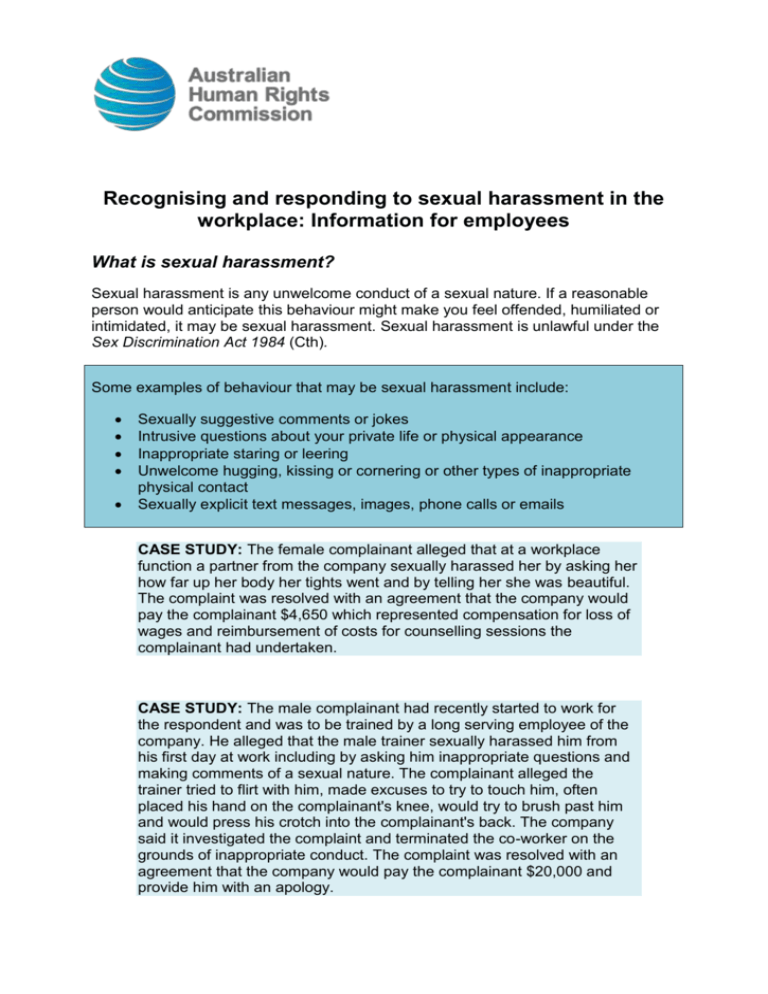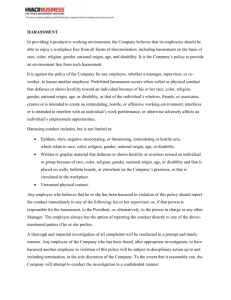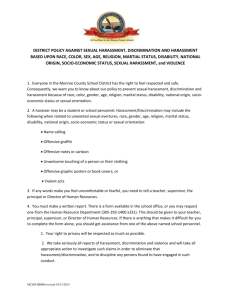
Recognising and responding to sexual harassment in the
workplace: Information for employees
What is sexual harassment?
Sexual harassment is any unwelcome conduct of a sexual nature. If a reasonable
person would anticipate this behaviour might make you feel offended, humiliated or
intimidated, it may be sexual harassment. Sexual harassment is unlawful under the
Sex Discrimination Act 1984 (Cth).
Some examples of behaviour that may be sexual harassment include:
Sexually suggestive comments or jokes
Intrusive questions about your private life or physical appearance
Inappropriate staring or leering
Unwelcome hugging, kissing or cornering or other types of inappropriate
physical contact
Sexually explicit text messages, images, phone calls or emails
CASE STUDY: The female complainant alleged that at a workplace
function a partner from the company sexually harassed her by asking her
how far up her body her tights went and by telling her she was beautiful.
The complaint was resolved with an agreement that the company would
pay the complainant $4,650 which represented compensation for loss of
wages and reimbursement of costs for counselling sessions the
complainant had undertaken.
CASE STUDY: The male complainant had recently started to work for
the respondent and was to be trained by a long serving employee of the
company. He alleged that the male trainer sexually harassed him from
his first day at work including by asking him inappropriate questions and
making comments of a sexual nature. The complainant alleged the
trainer tried to flirt with him, made excuses to try to touch him, often
placed his hand on the complainant's knee, would try to brush past him
and would press his crotch into the complainant's back. The company
said it investigated the complaint and terminated the co-worker on the
grounds of inappropriate conduct. The complaint was resolved with an
agreement that the company would pay the complainant $20,000 and
provide him with an apology.
CASE STUDY: The female complainant said she has been employed
with the respondent company for over 20 years. She claimed that her
manager sent her sexually explicit emails which she found offensive. The
respondents said the emails were sent as a joke and the particular
images the complainant referred to in her complaint, were taken out of
context. The complaint was resolved with an agreement that the
company would pay the complainant $10,000 in general damages and
$3,500 to cover her legal fees.
How common is sexual harassment in the workplace?
We are also seeing increasing rates of men being sexually harassed, by other men,
in the workplace.1
Where does workplace sexual harassment take place?
Under the Sex Discrimination Act 1984, a ‘workplace’ is:
Where the harasser works
Where the person being harassed works
Where they both work
The Sex Discrimination Act also covers ‘work related’ sexual harassment, which can
take place:
At the location of someone working remotely who is harassed by email, on a
social networking site, or by mobile phone.
On work-related trips (such as training and, conferences or in hotels, cars or
on trains etc).
At work-related social events (such as work lunches, office parties, at bars and
restaurants).
In classroom or training facilities or in the workplaces of interns, trainees and
apprentices.
In educational institutions and inter-school activities (sexual harassment can
be perpetrated by students over the age of 16 or by staff)
In shops, restaurants, or anywhere that goods and services are provided
(sexual harassment can be perpetrated by customers towards staff or by staff
towards customers).
2
Which workplace relationships are covered?
The relationship between the alleged harasser and the person allegedly harassed is
the key to understanding when the Sex Discrimination Act applies in the area of
employment.
Under the Act, it is unlawful to sexually harass:
an employee2, a commission agent3 or a contract worker
a prospective employee, commission agent or contract worker
a colleague, partner, fellow commission agent or fellow contract worker
a prospective colleague, partner, fellow commission agent or fellow contract
worker
another workplace participant (includes employers (eg sole trader), employees,
commission agents, contract workers and partners in a partnership).4
What can I do about sexual harassment in my workplace?
What can I do if I’m experiencing sexual harassment at work?
Raise the issue directly with the harasser and tell them that their behaviour is
unwelcome
Talk to a colleague for support
Talk to a union delegate or contact a union office for advice
Contact a community legal centre or working women’s centre for legal advice5
Contact 1800 RESPECT for telephone and online counselling, information and
referral
Make a complaint to your manager/employer
Contact the Australian Human Rights Commission or state and federal antidiscrimination agencies for information or to make a complaint.
How do I make a complaint to the Australian Human Rights Commission?
A person who believes he or she has been sexually harassed in the workplace can
make a complaint to the Australian Human Rights Commission alleging sexual
harassment under the Sex Discrimination Act 1984 (Cth). Or they can contact a
solicitor advocate or trade union to make a complaint to the Commission on their
behalf.
Australian Human Rights Commission’s National Information Service
Call us
Infoline: 1300 656 419 or (02) 9284 9888
TTY: 1800 620 241
If you need an interpreter you can call the Translating and Interpreting Service (TIS)
on 131 450 and ask to be connected to the Australian Human Rights Commission.
3
If you are deaf or have a hearing or speech impairment you can contact the National
Relay Service (NRS) on 133 677 (TTY/Voice) or 1300 555 727 (Speak & Listen) and
ask to be connected to the Australian Human Rights Commission.
Write to us
Postal Address: GPO Box 5218, Sydney NSW 2001
Email: infoservice@humanrights.gov.au
Fax: (02) 9284 9611
Go online
Website: www.humanrights.gov.au
Make a complaint: www.humanrights.gov.au/complaints/lodging-your-complaint
Why take action?
Evidence shows that reporting is an effective way to make the sexual harassment
stop.
45% of workplace sexual harassment
stops after a complaint or report is made.
6
I’m worried about what will happen if I make a complaint…
Many people are worried they will make things worse if they report their experience
of sexual harassment to their employer. Under federal legislation it is unlawful for an
employee to be disadvantaged because they’ve reported sexual harassment. For
example, it may be unlawful for your employer to move you to a position with fewer
responsibilities or give you a critical reference just because you’ve reported sexual
harassment.
How can I take action as a bystander?
People who see or hear about harassment in their workplace are called bystanders.
Active bystanders play a role to reduce the harm of sexual harassment and ensure
there is no tolerance for sexual harassment in their workplace.
You can talk to the person experiencing harassment:
Listen to them
Assist them in finding information or on how to make a complaint
4
There are also other things you can do:
Talk to your manager or supervisor about displaying the workplace sexual
harassment policy prominently in your workplace
Organise sexual harassment training for your workplace
Talk to Human Resources about implementing any sexual harassment
policies
Talk to a union delegate or union about raising awareness of sexual
harassment in the workplace
If you have the person experiencing the harassment’s permission you can
also report it to your employer.
What bystander action is possible will differ in different workplace contexts, so it may
be necessary to adapt what action you take to the context of your workplace.
The best thing you can do is to listen to the person who has been harassed and ask
them what support they would like.
Know where the line is
For information on sexual harassment, how to take bystander action or make a
complaint to the Australian Human Rights Commission see our website at:
www.knowtheline.com.au
1
Australian Human Rights Commission, Working without Fear: Results of the 2012 Sexual
Harassment National Telephone Survey (2012), p5. At: http://www.humanrights.gov.au/workingwithout-fear-results-sexual-harassment-national-telephone-survey-2012 (viewed 14 May 2014).
2 An employee includes full-time, part-time and casual workers as well as independent contractors.
3 A commission agent is a person who does work for another person as the agent of that other person
and who is remunerated, whether in whole or in part, by commission.
4
Sex Discrimination Act 1984 (Cth), ss 28B(1)-28B(6).
5
Community Legal Centres: http://www.naclc.org.au/need_legal_help.php
Women’s Legal Services: http://www.wlsa.org.au/members
Working Women’s Centres: http://www.wwc.org.au/
Victoria Legal Aid: http://www.legalaid.vic.gov.au/
Job Watch (Victoria): http://www.jobwatch.org.au/
Employment Law Centre of WA: http://elcwa.org.au/
6 Above n1, p5.
5









